Business Process Management
VerifiedAdded on 2023/01/18
|13
|1760
|64
AI Summary
This document provides an introduction to Business Process Management (BPM) and Business Process Reengineering (BPR). It discusses the benefits and shortcomings of BPM, the phases of BPM not in BPR, and the combination of BPM and BPR for continuous improvement. It also includes information on the foundations of BPMN and intermediate BPMN models.
Contribute Materials
Your contribution can guide someone’s learning journey. Share your
documents today.
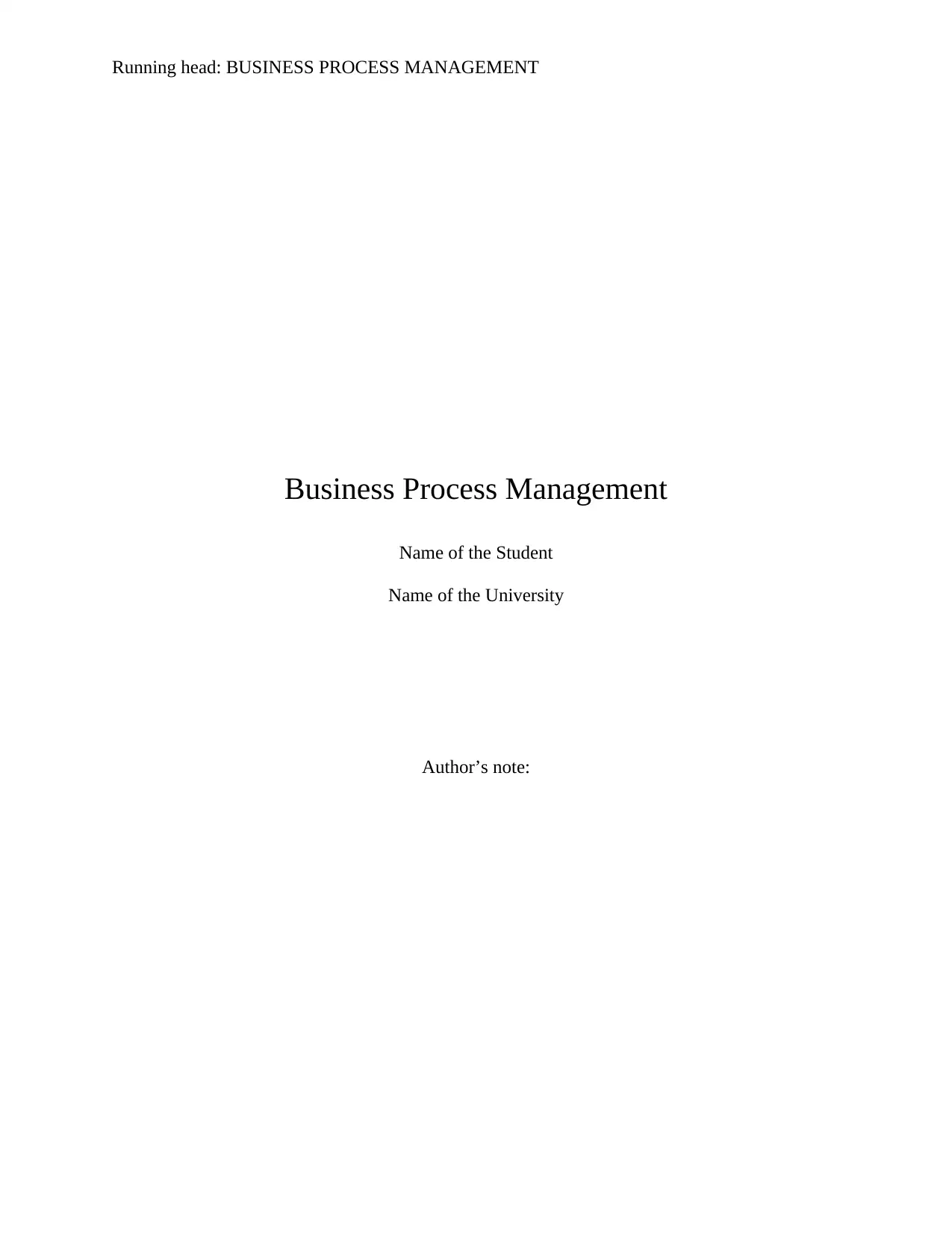
Running head: BUSINESS PROCESS MANAGEMENT
Business Process Management
Name of the Student
Name of the University
Author’s note:
Business Process Management
Name of the Student
Name of the University
Author’s note:
Secure Best Marks with AI Grader
Need help grading? Try our AI Grader for instant feedback on your assignments.

1BUSINESS PROCESS MANAGEMENT
Table of Contents
1. Introduction to Business Process Management:..........................................................................2
1.a Benefits and Shortcomings:...................................................................................................2
1.b Phases of BPM not in BPR:...................................................................................................3
1.c Combining BPM and BPR for Continuous Improvement:....................................................3
2. Foundations of BPMN:................................................................................................................4
3. Intermediate BPMN:....................................................................................................................5
3.1 Explaining BPMN Model:.....................................................................................................5
3.2 BPMN Model Review:..........................................................................................................5
3.3 BPMN Models:......................................................................................................................8
3.3.A Scenario 1:.....................................................................................................................8
3.3.B Scenario 2:......................................................................................................................9
3.4 Calculating Competitive Offer:.............................................................................................9
Bibliography:.................................................................................................................................11
Table of Contents
1. Introduction to Business Process Management:..........................................................................2
1.a Benefits and Shortcomings:...................................................................................................2
1.b Phases of BPM not in BPR:...................................................................................................3
1.c Combining BPM and BPR for Continuous Improvement:....................................................3
2. Foundations of BPMN:................................................................................................................4
3. Intermediate BPMN:....................................................................................................................5
3.1 Explaining BPMN Model:.....................................................................................................5
3.2 BPMN Model Review:..........................................................................................................5
3.3 BPMN Models:......................................................................................................................8
3.3.A Scenario 1:.....................................................................................................................8
3.3.B Scenario 2:......................................................................................................................9
3.4 Calculating Competitive Offer:.............................................................................................9
Bibliography:.................................................................................................................................11
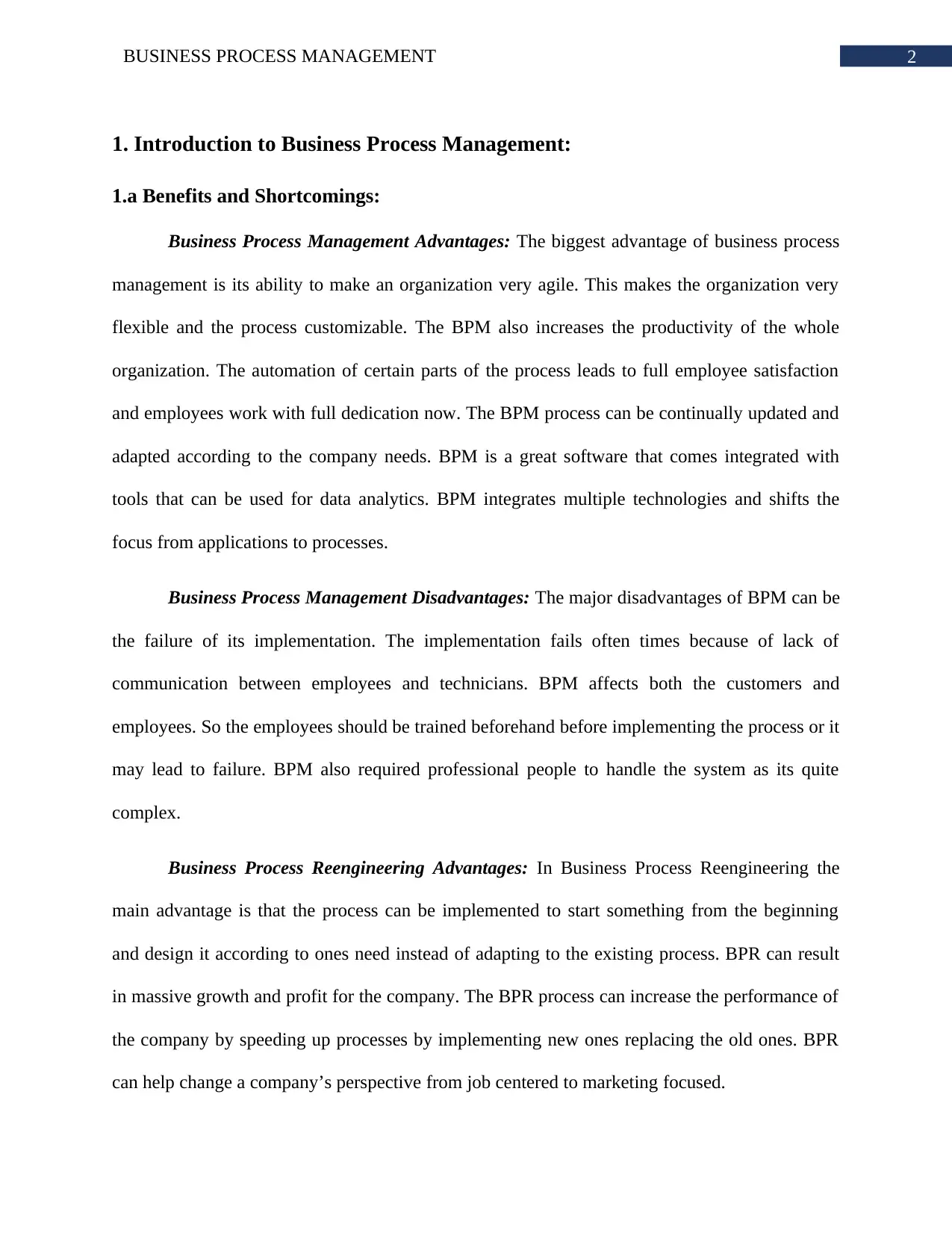
2BUSINESS PROCESS MANAGEMENT
1. Introduction to Business Process Management:
1.a Benefits and Shortcomings:
Business Process Management Advantages: The biggest advantage of business process
management is its ability to make an organization very agile. This makes the organization very
flexible and the process customizable. The BPM also increases the productivity of the whole
organization. The automation of certain parts of the process leads to full employee satisfaction
and employees work with full dedication now. The BPM process can be continually updated and
adapted according to the company needs. BPM is a great software that comes integrated with
tools that can be used for data analytics. BPM integrates multiple technologies and shifts the
focus from applications to processes.
Business Process Management Disadvantages: The major disadvantages of BPM can be
the failure of its implementation. The implementation fails often times because of lack of
communication between employees and technicians. BPM affects both the customers and
employees. So the employees should be trained beforehand before implementing the process or it
may lead to failure. BPM also required professional people to handle the system as its quite
complex.
Business Process Reengineering Advantages: In Business Process Reengineering the
main advantage is that the process can be implemented to start something from the beginning
and design it according to ones need instead of adapting to the existing process. BPR can result
in massive growth and profit for the company. The BPR process can increase the performance of
the company by speeding up processes by implementing new ones replacing the old ones. BPR
can help change a company’s perspective from job centered to marketing focused.
1. Introduction to Business Process Management:
1.a Benefits and Shortcomings:
Business Process Management Advantages: The biggest advantage of business process
management is its ability to make an organization very agile. This makes the organization very
flexible and the process customizable. The BPM also increases the productivity of the whole
organization. The automation of certain parts of the process leads to full employee satisfaction
and employees work with full dedication now. The BPM process can be continually updated and
adapted according to the company needs. BPM is a great software that comes integrated with
tools that can be used for data analytics. BPM integrates multiple technologies and shifts the
focus from applications to processes.
Business Process Management Disadvantages: The major disadvantages of BPM can be
the failure of its implementation. The implementation fails often times because of lack of
communication between employees and technicians. BPM affects both the customers and
employees. So the employees should be trained beforehand before implementing the process or it
may lead to failure. BPM also required professional people to handle the system as its quite
complex.
Business Process Reengineering Advantages: In Business Process Reengineering the
main advantage is that the process can be implemented to start something from the beginning
and design it according to ones need instead of adapting to the existing process. BPR can result
in massive growth and profit for the company. The BPR process can increase the performance of
the company by speeding up processes by implementing new ones replacing the old ones. BPR
can help change a company’s perspective from job centered to marketing focused.
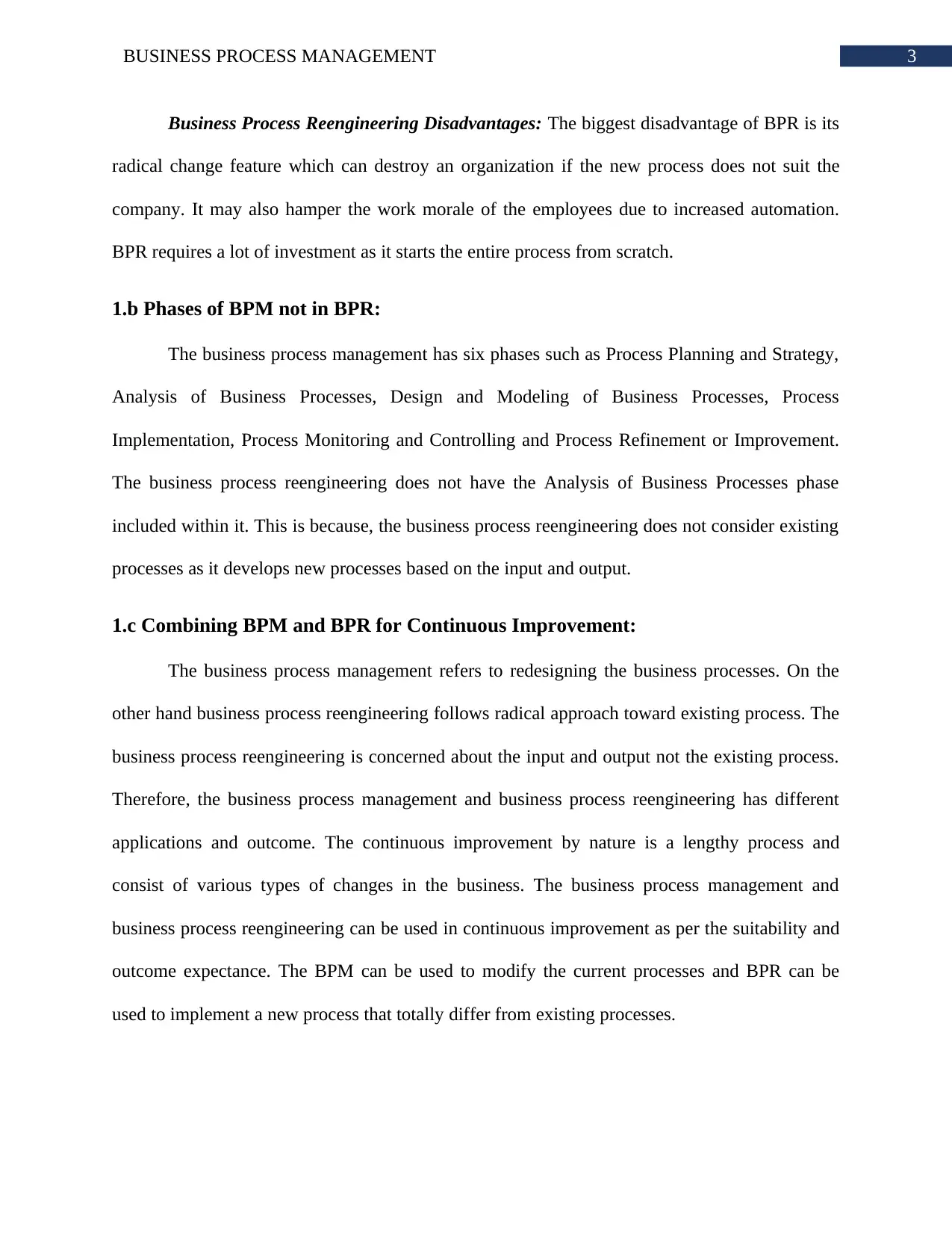
3BUSINESS PROCESS MANAGEMENT
Business Process Reengineering Disadvantages: The biggest disadvantage of BPR is its
radical change feature which can destroy an organization if the new process does not suit the
company. It may also hamper the work morale of the employees due to increased automation.
BPR requires a lot of investment as it starts the entire process from scratch.
1.b Phases of BPM not in BPR:
The business process management has six phases such as Process Planning and Strategy,
Analysis of Business Processes, Design and Modeling of Business Processes, Process
Implementation, Process Monitoring and Controlling and Process Refinement or Improvement.
The business process reengineering does not have the Analysis of Business Processes phase
included within it. This is because, the business process reengineering does not consider existing
processes as it develops new processes based on the input and output.
1.c Combining BPM and BPR for Continuous Improvement:
The business process management refers to redesigning the business processes. On the
other hand business process reengineering follows radical approach toward existing process. The
business process reengineering is concerned about the input and output not the existing process.
Therefore, the business process management and business process reengineering has different
applications and outcome. The continuous improvement by nature is a lengthy process and
consist of various types of changes in the business. The business process management and
business process reengineering can be used in continuous improvement as per the suitability and
outcome expectance. The BPM can be used to modify the current processes and BPR can be
used to implement a new process that totally differ from existing processes.
Business Process Reengineering Disadvantages: The biggest disadvantage of BPR is its
radical change feature which can destroy an organization if the new process does not suit the
company. It may also hamper the work morale of the employees due to increased automation.
BPR requires a lot of investment as it starts the entire process from scratch.
1.b Phases of BPM not in BPR:
The business process management has six phases such as Process Planning and Strategy,
Analysis of Business Processes, Design and Modeling of Business Processes, Process
Implementation, Process Monitoring and Controlling and Process Refinement or Improvement.
The business process reengineering does not have the Analysis of Business Processes phase
included within it. This is because, the business process reengineering does not consider existing
processes as it develops new processes based on the input and output.
1.c Combining BPM and BPR for Continuous Improvement:
The business process management refers to redesigning the business processes. On the
other hand business process reengineering follows radical approach toward existing process. The
business process reengineering is concerned about the input and output not the existing process.
Therefore, the business process management and business process reengineering has different
applications and outcome. The continuous improvement by nature is a lengthy process and
consist of various types of changes in the business. The business process management and
business process reengineering can be used in continuous improvement as per the suitability and
outcome expectance. The BPM can be used to modify the current processes and BPR can be
used to implement a new process that totally differ from existing processes.
Secure Best Marks with AI Grader
Need help grading? Try our AI Grader for instant feedback on your assignments.
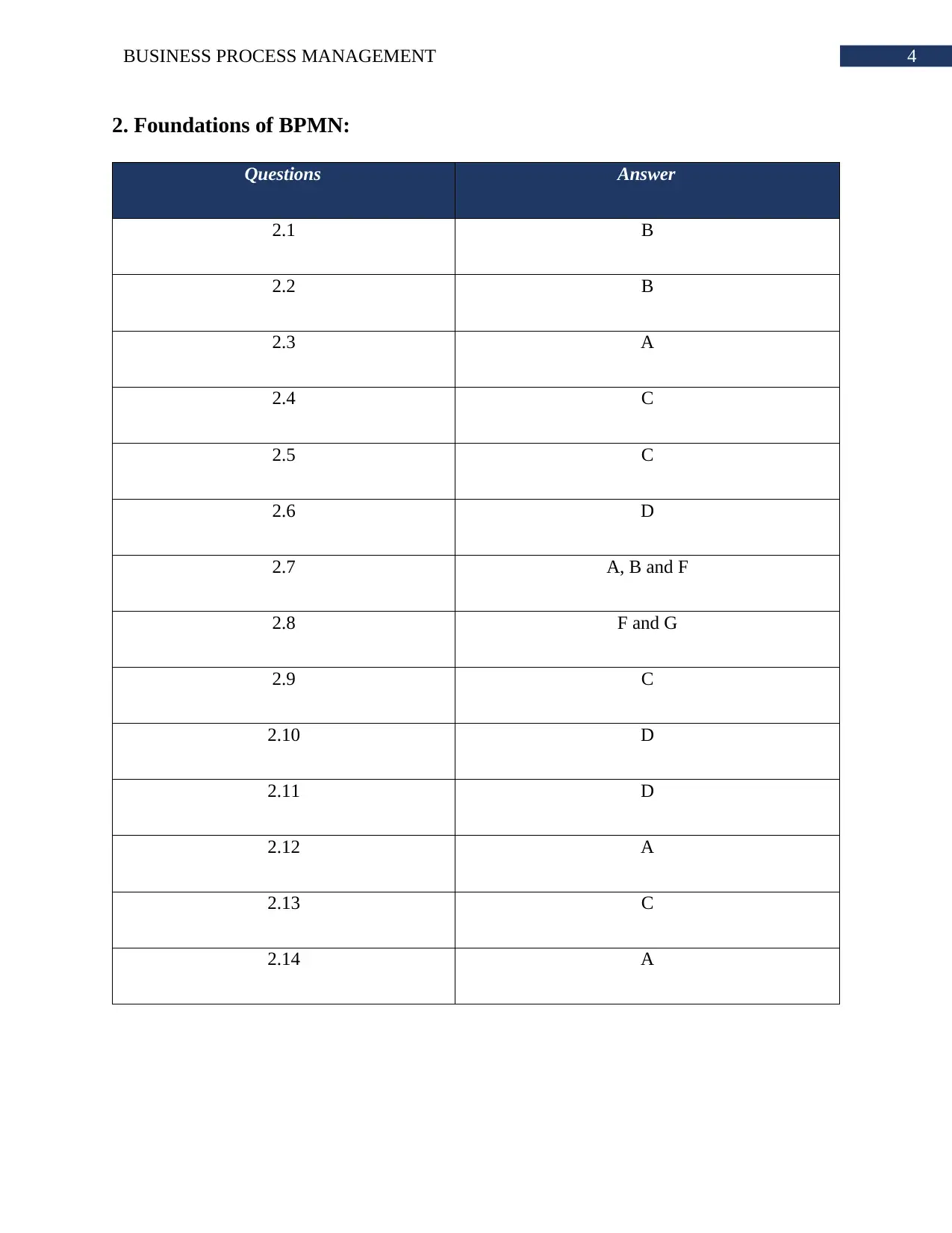
4BUSINESS PROCESS MANAGEMENT
2. Foundations of BPMN:
Questions Answer
2.1 B
2.2 B
2.3 A
2.4 C
2.5 C
2.6 D
2.7 A, B and F
2.8 F and G
2.9 C
2.10 D
2.11 D
2.12 A
2.13 C
2.14 A
2. Foundations of BPMN:
Questions Answer
2.1 B
2.2 B
2.3 A
2.4 C
2.5 C
2.6 D
2.7 A, B and F
2.8 F and G
2.9 C
2.10 D
2.11 D
2.12 A
2.13 C
2.14 A
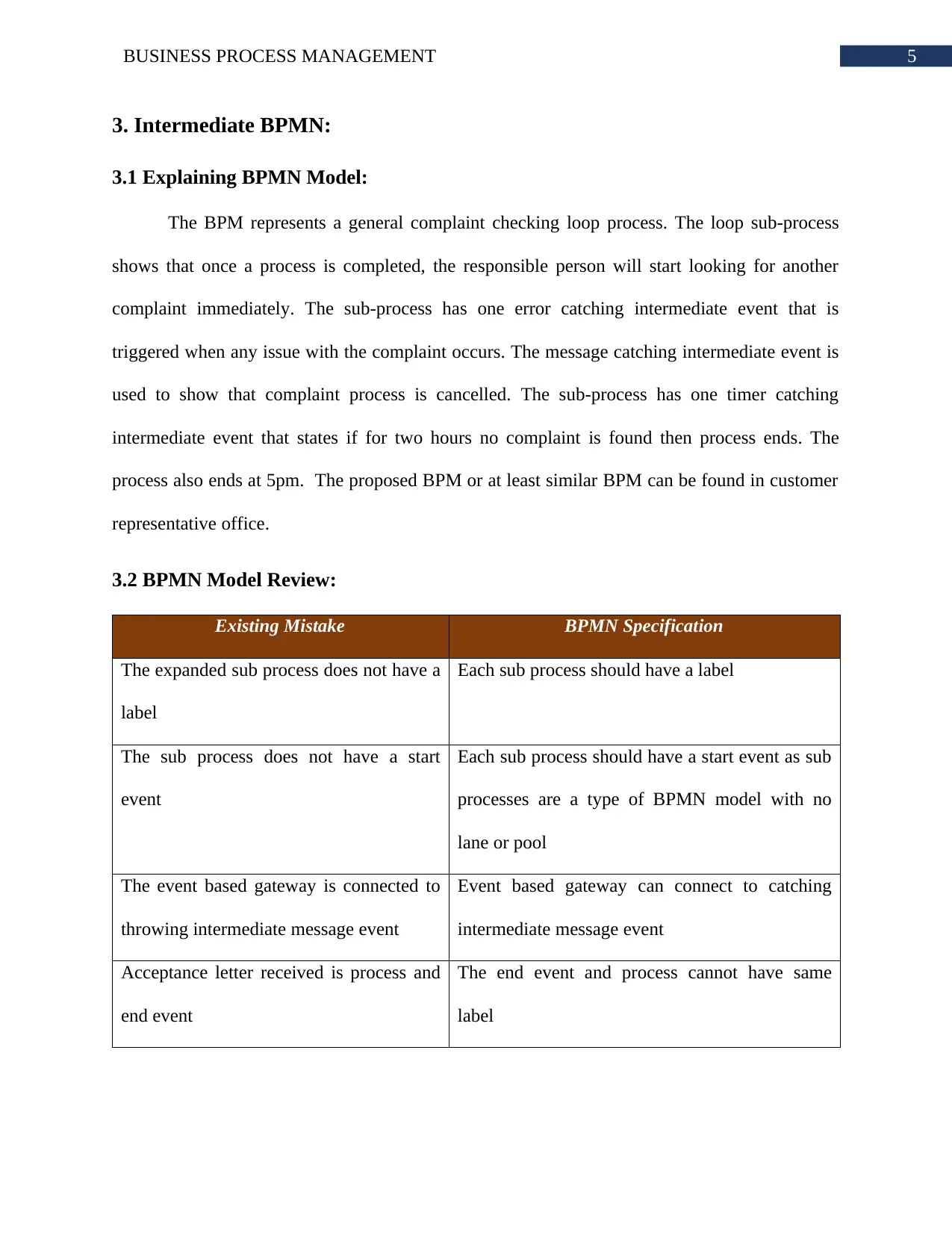
5BUSINESS PROCESS MANAGEMENT
3. Intermediate BPMN:
3.1 Explaining BPMN Model:
The BPM represents a general complaint checking loop process. The loop sub-process
shows that once a process is completed, the responsible person will start looking for another
complaint immediately. The sub-process has one error catching intermediate event that is
triggered when any issue with the complaint occurs. The message catching intermediate event is
used to show that complaint process is cancelled. The sub-process has one timer catching
intermediate event that states if for two hours no complaint is found then process ends. The
process also ends at 5pm. The proposed BPM or at least similar BPM can be found in customer
representative office.
3.2 BPMN Model Review:
Existing Mistake BPMN Specification
The expanded sub process does not have a
label
Each sub process should have a label
The sub process does not have a start
event
Each sub process should have a start event as sub
processes are a type of BPMN model with no
lane or pool
The event based gateway is connected to
throwing intermediate message event
Event based gateway can connect to catching
intermediate message event
Acceptance letter received is process and
end event
The end event and process cannot have same
label
3. Intermediate BPMN:
3.1 Explaining BPMN Model:
The BPM represents a general complaint checking loop process. The loop sub-process
shows that once a process is completed, the responsible person will start looking for another
complaint immediately. The sub-process has one error catching intermediate event that is
triggered when any issue with the complaint occurs. The message catching intermediate event is
used to show that complaint process is cancelled. The sub-process has one timer catching
intermediate event that states if for two hours no complaint is found then process ends. The
process also ends at 5pm. The proposed BPM or at least similar BPM can be found in customer
representative office.
3.2 BPMN Model Review:
Existing Mistake BPMN Specification
The expanded sub process does not have a
label
Each sub process should have a label
The sub process does not have a start
event
Each sub process should have a start event as sub
processes are a type of BPMN model with no
lane or pool
The event based gateway is connected to
throwing intermediate message event
Event based gateway can connect to catching
intermediate message event
Acceptance letter received is process and
end event
The end event and process cannot have same
label
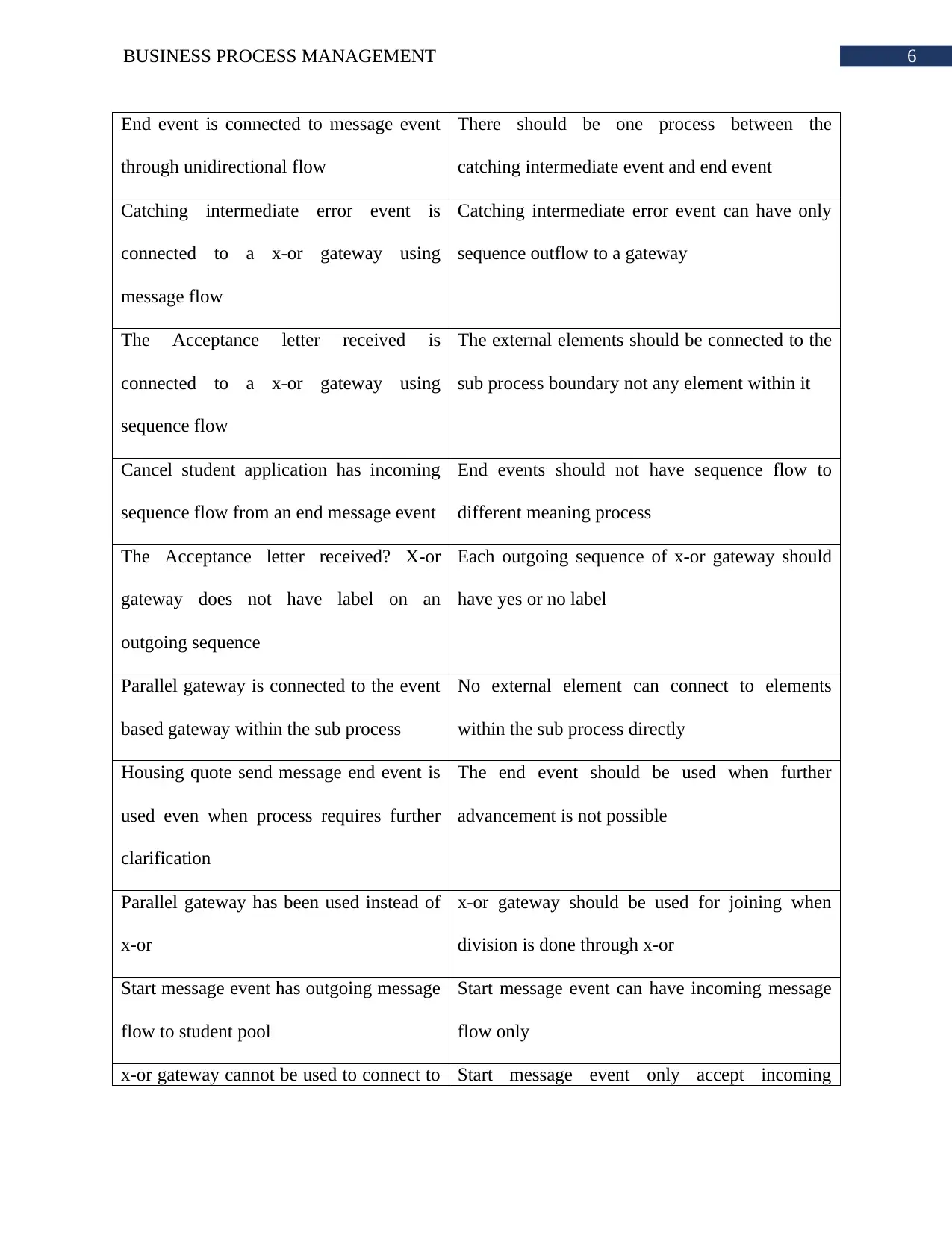
6BUSINESS PROCESS MANAGEMENT
End event is connected to message event
through unidirectional flow
There should be one process between the
catching intermediate event and end event
Catching intermediate error event is
connected to a x-or gateway using
message flow
Catching intermediate error event can have only
sequence outflow to a gateway
The Acceptance letter received is
connected to a x-or gateway using
sequence flow
The external elements should be connected to the
sub process boundary not any element within it
Cancel student application has incoming
sequence flow from an end message event
End events should not have sequence flow to
different meaning process
The Acceptance letter received? X-or
gateway does not have label on an
outgoing sequence
Each outgoing sequence of x-or gateway should
have yes or no label
Parallel gateway is connected to the event
based gateway within the sub process
No external element can connect to elements
within the sub process directly
Housing quote send message end event is
used even when process requires further
clarification
The end event should be used when further
advancement is not possible
Parallel gateway has been used instead of
x-or
x-or gateway should be used for joining when
division is done through x-or
Start message event has outgoing message
flow to student pool
Start message event can have incoming message
flow only
x-or gateway cannot be used to connect to Start message event only accept incoming
End event is connected to message event
through unidirectional flow
There should be one process between the
catching intermediate event and end event
Catching intermediate error event is
connected to a x-or gateway using
message flow
Catching intermediate error event can have only
sequence outflow to a gateway
The Acceptance letter received is
connected to a x-or gateway using
sequence flow
The external elements should be connected to the
sub process boundary not any element within it
Cancel student application has incoming
sequence flow from an end message event
End events should not have sequence flow to
different meaning process
The Acceptance letter received? X-or
gateway does not have label on an
outgoing sequence
Each outgoing sequence of x-or gateway should
have yes or no label
Parallel gateway is connected to the event
based gateway within the sub process
No external element can connect to elements
within the sub process directly
Housing quote send message end event is
used even when process requires further
clarification
The end event should be used when further
advancement is not possible
Parallel gateway has been used instead of
x-or
x-or gateway should be used for joining when
division is done through x-or
Start message event has outgoing message
flow to student pool
Start message event can have incoming message
flow only
x-or gateway cannot be used to connect to Start message event only accept incoming
Paraphrase This Document
Need a fresh take? Get an instant paraphrase of this document with our AI Paraphraser
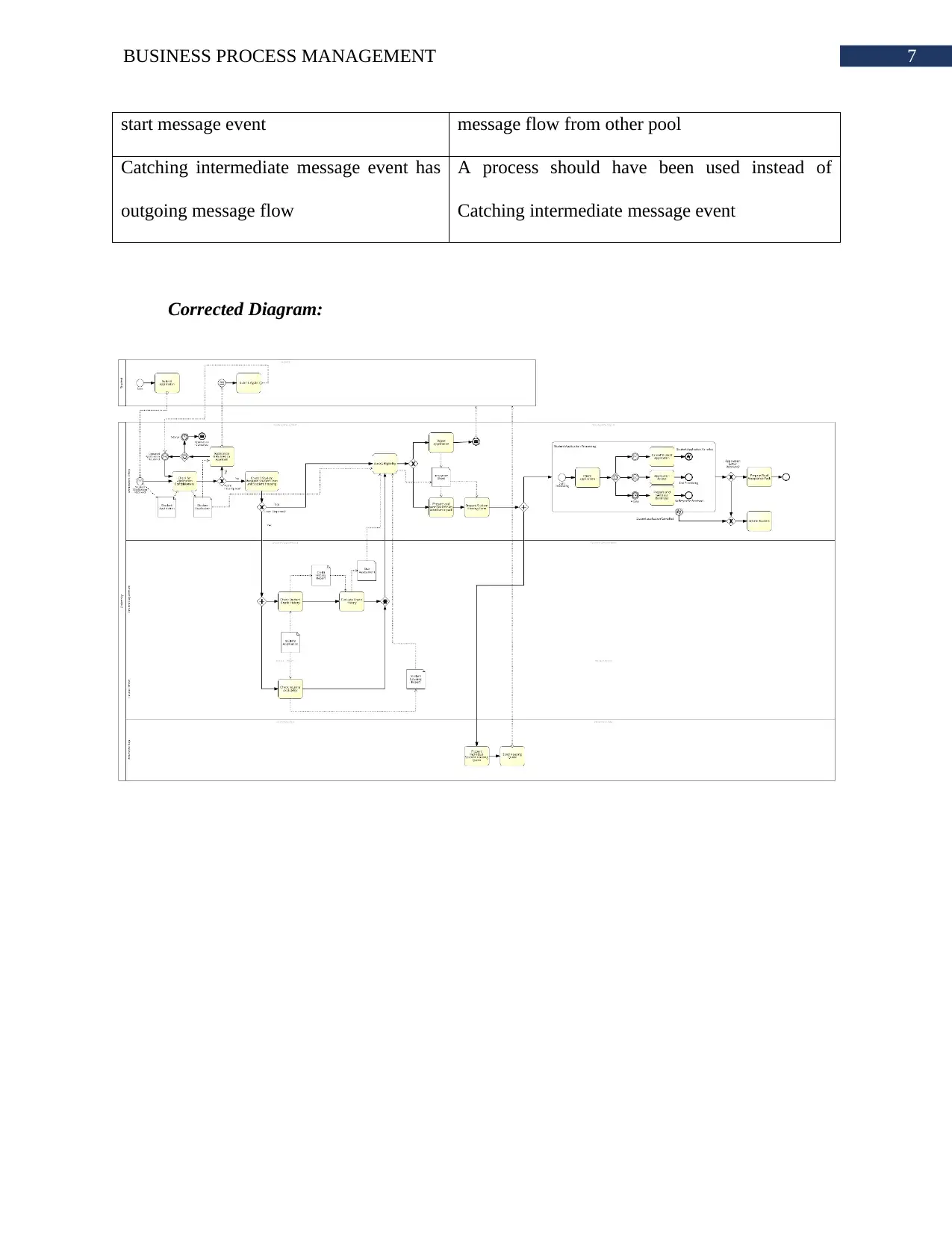
7BUSINESS PROCESS MANAGEMENT
start message event message flow from other pool
Catching intermediate message event has
outgoing message flow
A process should have been used instead of
Catching intermediate message event
Corrected Diagram:
start message event message flow from other pool
Catching intermediate message event has
outgoing message flow
A process should have been used instead of
Catching intermediate message event
Corrected Diagram:
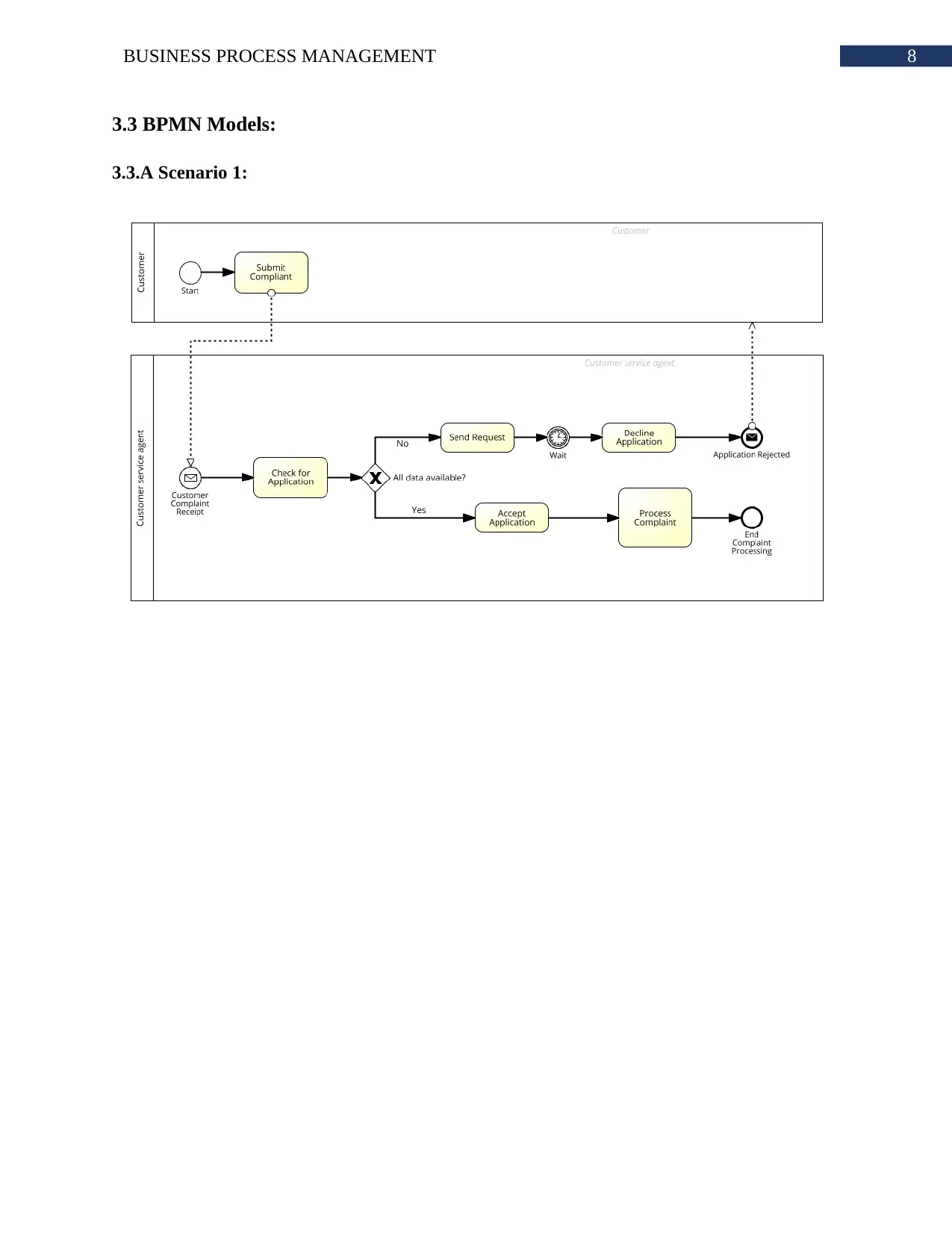
8BUSINESS PROCESS MANAGEMENT
3.3 BPMN Models:
3.3.A Scenario 1:
3.3 BPMN Models:
3.3.A Scenario 1:

9BUSINESS PROCESS MANAGEMENT
3.3.B Scenario 2:
3.4 Calculating Competitive Offer:
Sale price is $215,000.00.
Project internal cost is $170,743.00.
Project Revenue is $210,629.00
Duration of the project is 105 days.
The project team size is fifteen workers.
Role Headcount
ICR/
hour ECR/day
MA 1 180 1500
LA 4 160 1300
CA 8 100 1000
YA 2 80 900
3.3.B Scenario 2:
3.4 Calculating Competitive Offer:
Sale price is $215,000.00.
Project internal cost is $170,743.00.
Project Revenue is $210,629.00
Duration of the project is 105 days.
The project team size is fifteen workers.
Role Headcount
ICR/
hour ECR/day
MA 1 180 1500
LA 4 160 1300
CA 8 100 1000
YA 2 80 900
Secure Best Marks with AI Grader
Need help grading? Try our AI Grader for instant feedback on your assignments.
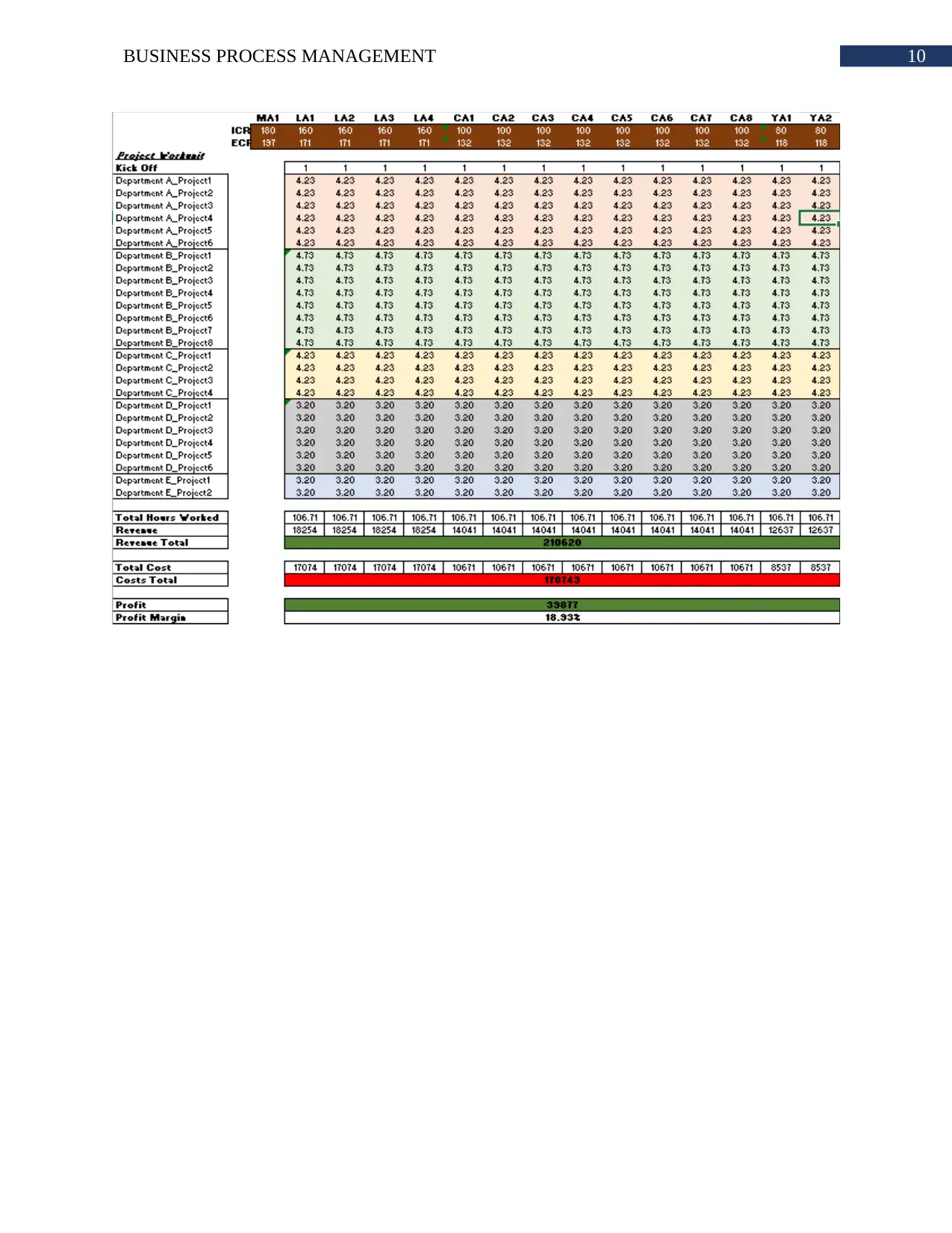
10BUSINESS PROCESS MANAGEMENT
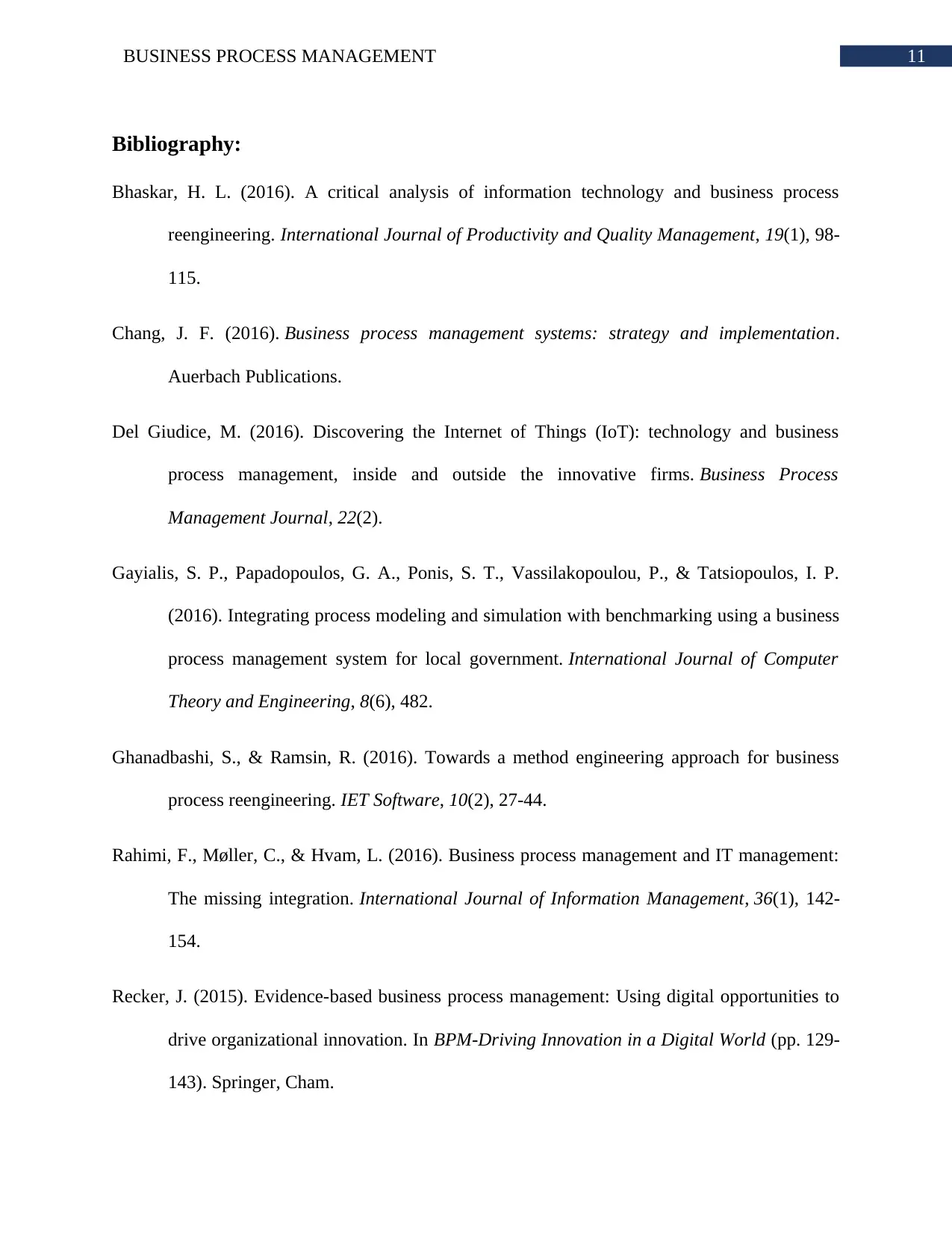
11BUSINESS PROCESS MANAGEMENT
Bibliography:
Bhaskar, H. L. (2016). A critical analysis of information technology and business process
reengineering. International Journal of Productivity and Quality Management, 19(1), 98-
115.
Chang, J. F. (2016). Business process management systems: strategy and implementation.
Auerbach Publications.
Del Giudice, M. (2016). Discovering the Internet of Things (IoT): technology and business
process management, inside and outside the innovative firms. Business Process
Management Journal, 22(2).
Gayialis, S. P., Papadopoulos, G. A., Ponis, S. T., Vassilakopoulou, P., & Tatsiopoulos, I. P.
(2016). Integrating process modeling and simulation with benchmarking using a business
process management system for local government. International Journal of Computer
Theory and Engineering, 8(6), 482.
Ghanadbashi, S., & Ramsin, R. (2016). Towards a method engineering approach for business
process reengineering. IET Software, 10(2), 27-44.
Rahimi, F., Møller, C., & Hvam, L. (2016). Business process management and IT management:
The missing integration. International Journal of Information Management, 36(1), 142-
154.
Recker, J. (2015). Evidence-based business process management: Using digital opportunities to
drive organizational innovation. In BPM-Driving Innovation in a Digital World (pp. 129-
143). Springer, Cham.
Bibliography:
Bhaskar, H. L. (2016). A critical analysis of information technology and business process
reengineering. International Journal of Productivity and Quality Management, 19(1), 98-
115.
Chang, J. F. (2016). Business process management systems: strategy and implementation.
Auerbach Publications.
Del Giudice, M. (2016). Discovering the Internet of Things (IoT): technology and business
process management, inside and outside the innovative firms. Business Process
Management Journal, 22(2).
Gayialis, S. P., Papadopoulos, G. A., Ponis, S. T., Vassilakopoulou, P., & Tatsiopoulos, I. P.
(2016). Integrating process modeling and simulation with benchmarking using a business
process management system for local government. International Journal of Computer
Theory and Engineering, 8(6), 482.
Ghanadbashi, S., & Ramsin, R. (2016). Towards a method engineering approach for business
process reengineering. IET Software, 10(2), 27-44.
Rahimi, F., Møller, C., & Hvam, L. (2016). Business process management and IT management:
The missing integration. International Journal of Information Management, 36(1), 142-
154.
Recker, J. (2015). Evidence-based business process management: Using digital opportunities to
drive organizational innovation. In BPM-Driving Innovation in a Digital World (pp. 129-
143). Springer, Cham.

12BUSINESS PROCESS MANAGEMENT
Reichert, M., Hallerbach, A., & Bauer, T. (2015). Lifecycle management of business process
variants. In Handbook on Business Process Management 1 (pp. 251-278). Springer,
Berlin, Heidelberg.
Spanyi, A. (2015). The governance of business process management. In Handbook on Business
Process Management 2 (pp. 333-349). Springer, Berlin, Heidelberg.
Sun, Y., Su, J., & Yang, J. (2016). Universal artifacts: a new approach to business process
management (BPM) systems. ACM Transactions on Management Information Systems
(TMIS), 7(1), 3.
van der Aalst, W. M. (2015). Business process management as the “Killer App” for Petri
nets. Software & Systems Modeling, 14(2), 685-691.
Reichert, M., Hallerbach, A., & Bauer, T. (2015). Lifecycle management of business process
variants. In Handbook on Business Process Management 1 (pp. 251-278). Springer,
Berlin, Heidelberg.
Spanyi, A. (2015). The governance of business process management. In Handbook on Business
Process Management 2 (pp. 333-349). Springer, Berlin, Heidelberg.
Sun, Y., Su, J., & Yang, J. (2016). Universal artifacts: a new approach to business process
management (BPM) systems. ACM Transactions on Management Information Systems
(TMIS), 7(1), 3.
van der Aalst, W. M. (2015). Business process management as the “Killer App” for Petri
nets. Software & Systems Modeling, 14(2), 685-691.
1 out of 13
Related Documents
Your All-in-One AI-Powered Toolkit for Academic Success.
+13062052269
info@desklib.com
Available 24*7 on WhatsApp / Email
![[object Object]](/_next/static/media/star-bottom.7253800d.svg)
Unlock your academic potential
© 2024 | Zucol Services PVT LTD | All rights reserved.




